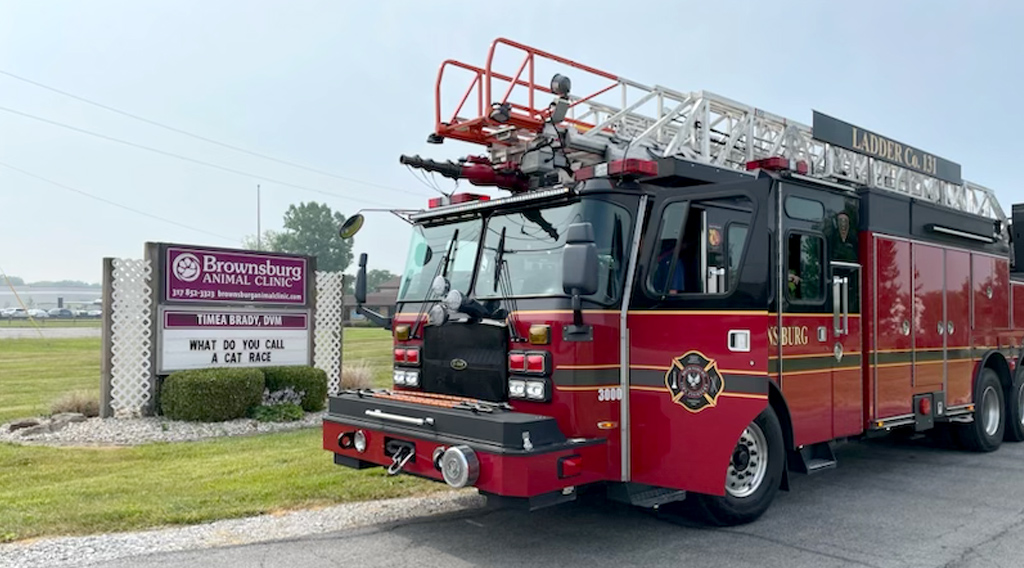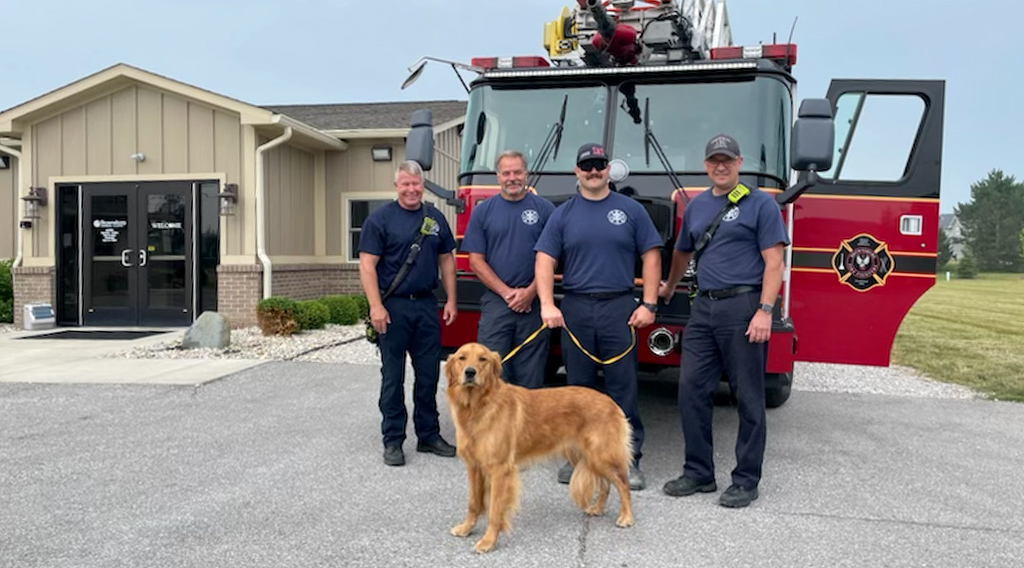The National Fire Protection Association reports at least 40,000 pets die each year in house fires, often because of smoke inhalation.
In observance of National Pet Fire Safety Day on July 15, with help from Brownsburg Fire Territory Public Education Manager Nina Powell, we’ve compiled a number of precautions you can take to help keep your pet safe from fire.
Fire Prevention
According to American Humane, more than 500,000 pets are affected each year by house fires, including more than 1,000 fires started by pets.
One of the most common ways pets start fires results from their access to open flames from candles or fireplaces. One cat knocked burning candles off a bedroom shelf onto a mattress, starting a fire that destroyed most of the house. Other cats and dogs have suffered serious burns by brushing too close to a candle or fireplace flame and setting their fur on fire.
To avoid such mishaps, we advise you never to leave a pet unattended around an open flame. Protect burning candles with hurricane glass holders with heavy bases and use a fire screen to shield pets from fireplace fires. Better yet, use battery-powered flameless candles and enclose your fireplace in glass to eliminate this risk.
Pets sometimes start fires by pawing stove burner knobs. A dog jumped up on a stove to get a slice of pizza from a box left on the stovetop and in the process, turned on a burner. The pizza box caught fire, quickly spreading flames through the rest of the kitchen. If your pet is able to reach the stove or climb onto the control panel from a countertop, cover or remove the knobs and activate child safety lock features, if available.
Electrical fires can start after a pet chews the insulation off a loose power cord. Use cord covers to protect exposed cords from chewing. Search online for “dog and cat power cord covers” to see the many options available.
“Although we haven’t had any incidents here in Brownsburg, nationwide one of the concerns is with heating lamps for pet reptiles,” said Powell. “If those lamps aren’t properly managed according to the manufacturers’ instructions, they can start fires.”
One dog started a fire by pulling his bed up against a portable space heater. The bed ignited, and the fire spread, damaging the house and sending both the dog and owner to the hospital. If you use a portable heater, make sure yours stays relatively cool to the touch and automatically shuts off if knocked over.
“All the modern space heaters have the tip-over feature with automatic shut-off,” said Powell. “I would definitely tell someone who is using an older model space heater to replace it with a newer one with that tip-over feature.”
Don’t leave your pet unattended in a room with a portable heater.
Install smoke detectors monitored by an emergency response service. Whether or not you are home to report the fire, fire fighters can be dispatched quickly after the alarm is activated to help save your home and family—including your pet.
“I’m 100% in favor of interconnected smoke alarms so when one goes off, all go off,” said Powell. “Even better are interconnected smoke alarms that are monitored.”

Sadly, two pets—a dog and a cat—died in Brownsburg house fires this year. “It’s very devastating for us personally and hard to tell the owners,” said Powell.
“Fortunately, we’ve had several occasions this year where we’ve saved pets from fires,” said Powell. “Every one of our fire trucks has O2 masks for pets so we can resuscitate them.”
Fire Emergency Preparation
Make and rehearse an emergency home evacuation plan that includes your pet.
See our blog post “Preparing Your Pets for Disaster” for general information about planning for emergencies.
“Practice your fire escape plan with your family and your pet,” advised Powell. “With your smoke alarm in test mode, let your pet hear the sound the alarm makes and show them where they’re supposed to go when they hear that sound.”
Powell emphasized that step one in any emergency is to call 911.
“The sooner you call 911, the sooner the fire fighters can get to your house and rescue you and your pet.”
Family members should not endanger their own lives attempting to rescue a pet. If the pet can’t be found and brought to safety immediately, leave the door open and call to the pet from a safe distance outside.
“Of course, if the pet is right there and can safely exit the house along with the people, that’s great,” Powell said. “But some pets are programmed to hide in an emergency like a house fire, and we don’t encourage people to delay their exit while they search inside a burning house for a pet.
“Please exit the home and call us immediately.”
Once fire fighters arrive, let them know a pet is still inside. “It helps if you describe the pet to the crew and tell them its name and any words it might respond to,” said Powell.
In case your pet gets lost in the confusion of a house fire, make sure he or she is microchipped and wearing a collar with identification tags attached. For details, see our post, “How to Get a Lost Pet Back Home.”
For Owners of Service Animals
Owners of service dogs may call the Brownsburg Fire Territory’s non-emergency number at (317) 852-1190 to have notes about the presence of a service animal added to the records for their address.
As defined by the Americans with Disabilities Act, a “service animal means any dog that is individually trained to do work or perform tasks for the benefit of an individual with a disability, including a physical, sensory, psychiatric, intellectual, or other mental disability.”
“It helps us to know about the service animal at that address ahead of time and anticipate any possible delay in the owner’s exiting due to a disability,” Powell said.

